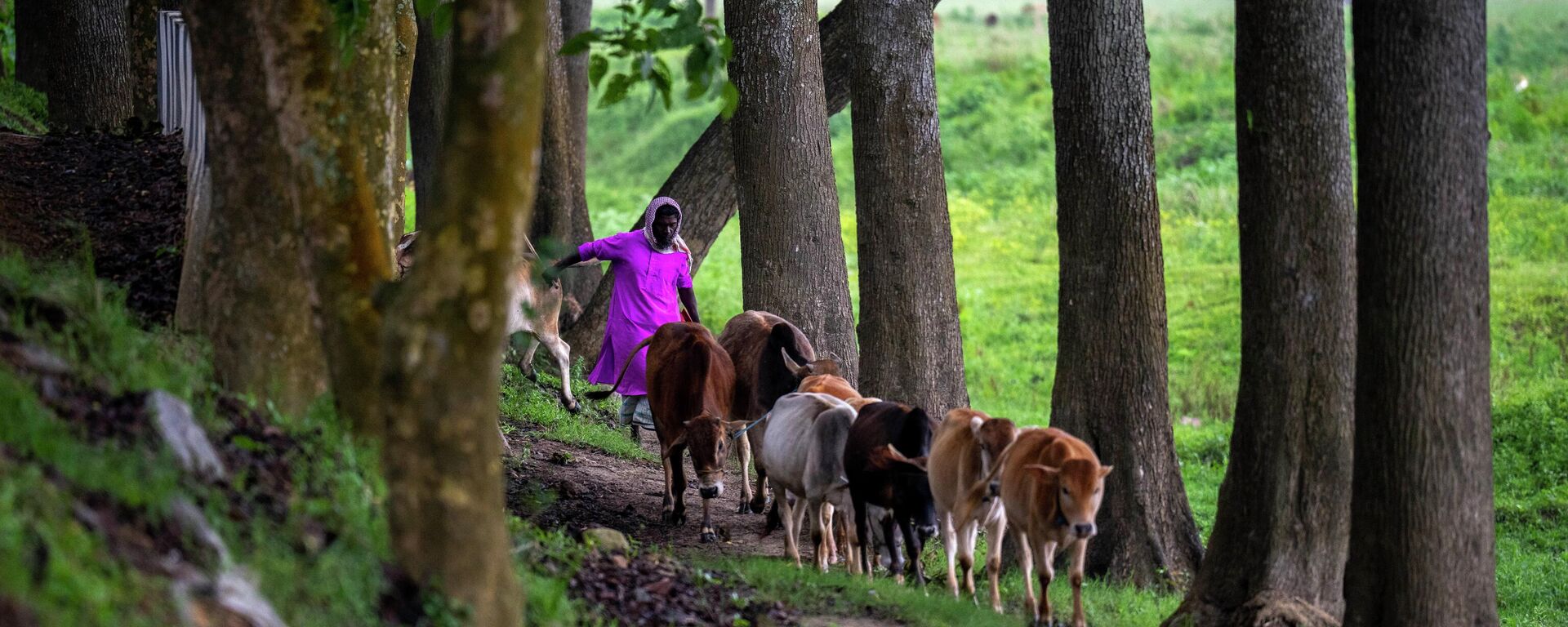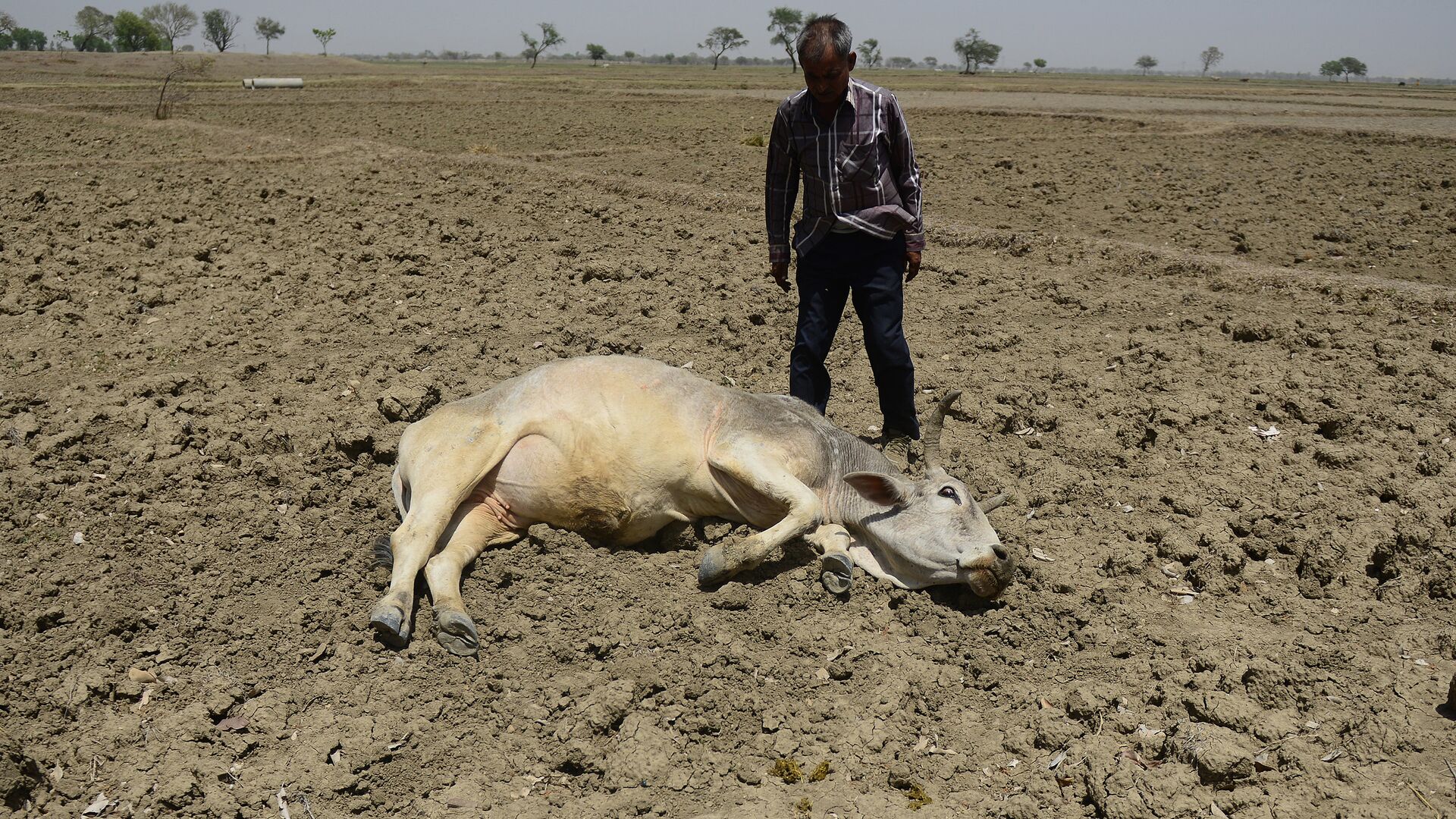https://sputnikglobe.com/20220930/researchers-discover-6-variants-of-lumpy-skin-disease-that-killed-nearly-100000-cattle-in-india-1101362561.html
Researchers Discover 6 Variants of Lumpy Skin Disease That Has Killed Nearly 100,000 Cattle in India
Researchers Discover 6 Variants of Lumpy Skin Disease That Has Killed Nearly 100,000 Cattle in India
Sputnik International
The first case of Lumpy Skin Disease (LSD) was recorded in Zambia in 1929. It proceeded to spread from Africa to several parts of Europe. In South Asia, the... 30.09.2022, Sputnik International
2022-09-30T15:51+0000
2022-09-30T15:51+0000
2023-10-27T10:10+0000
india
cow
cow
disease
buffalo
virus transmission
disease
skin
vaccine
vaccine
https://cdn1.img.sputnikglobe.com/img/103849/33/1038493308_0:157:3500:2126_1920x0_80_0_0_647e7a9ecfeb88c836208e751b1e6bbd.jpg
As an outbreak of lumpy skin disease causes havoc in India, researchers have discovered six variants of the virus which has killed nearly 100,000 cows and buffaloes and infected more than 2 million more in 15 states.The disease spreads through mosquitoes and ticks whose bites leave the cows and buffaloes with a high fever and lumps on their skin.According to official figures, the number of cows and buffaloes that have died has doubled in three weeks and has spread across 15 states including Gujarat, Rajasthan, Punjab, Haryana, Uttar Pradesh, Uttarakhand, Madhya Pradesh, and the Jammu and Kashmir union territory. Rajasthan has suffered the worst with more than 60,000 cattle reportedly found dead, and nearly 1.4 million infected.According to reports, several carcasses of cows and buffaloes have been left to rot in the open and the bellows of pain from the sick animals echo through the villages. Deadly Variant of LSD The LSD epidemic struck India for the first time in 2019 but because it was a relatively mild bout, the veterinary units of several states brought it quickly under control.In 2022, LSD started to look as though it was mirroring COVID as in past two years the virus has evolved with time.Although veterinary epidemiologists in every state are continually monitoring and tracking the disease, researchers suspect there are many ways the virus can be spread."It has been said that the virus is spread by a particular vector. However, there can be other carriers of the virus, as there have been cases reported from the Himalayan region of Uttarkashi, which had connection with other regions of infection. There's more than just one communicable factor," Dr Sharma said. Vaccination and Treatment The Uttarakhand authorities have taken a holistic approach that includes mass vaccination, and spreading awareness to locals about how to protect their cattle, and what to do to the ones who have been infected with LSD."Out of 27,000 cases, 13,000 have recovered which is just less than 50 percent of the group. The death rate of cows and buffaloes has fallen to 1.8 percent," Dr Sharma added.Vets have been playing a big role in trying to treat the symptoms and build immunity in cattle. "For fever, paracetamol is given to them. To prevent the lumps bursting, we are giving antibiotics. Good immunity is helping the cattle to recover in five days, thus we are giving them an immunity booster, [traditional Indian] Ayurvedic supplements and mineral supplements," Dr Sahrma said. He added that though the local scientists have developed a vaccine to control LSD in cattle, it has yet to come to the market. "We are planning to incorporate the new vaccine in the annual cattle vaccination program next year," he said.Impact on Milk ProductionIndia is said to be the world's largest milk producer and dairy farming is among the largest agricultural commodities in India, employing 80 million people and contributing to 5 percent of its economy, according to official data. However, because of the incidence of the LSD virus in India, the industry has suffered a terrible blow as cattle farmers face huge losses - not just because of cows and buffaloes dying but also because infected cattle are producing less milk than before and calving has been affected.“There are several people who recently ventured into the dairy business or switched their career completely, and for them the LSD epidemic has been a big setback," Dr Sharma said.Farmers' associations in Himachal Pradesh and elsewhere have urged their respective state government for financial aid.
https://sputnikglobe.com/20220912/indian-scientists-develop-lumpy-skin-disease-vaccine-for-cattle-modi-states-at-world-dairy-summit-1100688656.html
Sputnik International
feedback@sputniknews.com
+74956456601
MIA „Rossiya Segodnya“
2022
Sangeeta Yadav
https://cdn1.img.sputnikglobe.com/img/07e4/08/1b/1080292803_0:121:960:1081_100x100_80_0_0_7490b319dab9611e309056b177265184.jpg
Sangeeta Yadav
https://cdn1.img.sputnikglobe.com/img/07e4/08/1b/1080292803_0:121:960:1081_100x100_80_0_0_7490b319dab9611e309056b177265184.jpg
News
en_EN
Sputnik International
feedback@sputniknews.com
+74956456601
MIA „Rossiya Segodnya“
Sputnik International
feedback@sputniknews.com
+74956456601
MIA „Rossiya Segodnya“
Sangeeta Yadav
https://cdn1.img.sputnikglobe.com/img/07e4/08/1b/1080292803_0:121:960:1081_100x100_80_0_0_7490b319dab9611e309056b177265184.jpg
india, cow, cow, disease, buffalo, virus transmission, disease, skin, vaccine, vaccine, vaccination, vaccinations, treatment, mass, death, virus
india, cow, cow, disease, buffalo, virus transmission, disease, skin, vaccine, vaccine, vaccination, vaccinations, treatment, mass, death, virus
Researchers Discover 6 Variants of Lumpy Skin Disease That Has Killed Nearly 100,000 Cattle in India
15:51 GMT 30.09.2022 (Updated: 10:10 GMT 27.10.2023) The first case of Lumpy Skin Disease (LSD) was recorded in Zambia in 1929. It proceeded to spread from Africa to several parts of Europe. In South Asia, the first case of LSD was reported in Bangladesh in 2019. It subsequently affected the neighboring countries of India, China, and Nepal.
As an outbreak of lumpy skin disease
causes havoc in India, researchers have discovered six variants of the virus which has killed nearly 100,000 cows and buffaloes and infected more than 2 million more in 15 states.
The disease spreads through mosquitoes and ticks whose bites leave the cows and buffaloes with a high fever and lumps on their skin.
According to official figures, the
number of cows and buffaloes that have died has doubled in three weeks and has spread across 15 states including Gujarat, Rajasthan, Punjab, Haryana, Uttar Pradesh, Uttarakhand, Madhya Pradesh, and the Jammu and Kashmir union territory.
"The most pressing need is to control the spread of the virus," Dr Devendra Sharma, joint director of disease control at Uttarakhand state’s Animal Husbandry Department told Sputnik, adding that the situation is getting slightly better in his state.
Rajasthan has suffered the worst with more than 60,000 cattle reportedly found dead, and nearly 1.4 million infected.
According to reports, several carcasses of cows and buffaloes have been left to rot in the open and the bellows of pain from the sick animals echo through the villages.
The LSD epidemic struck India for the first time in 2019 but because it was a relatively mild bout, the veterinary units of several states brought it quickly under control.
In 2022, LSD started to look as though it was mirroring COVID as in past two years the virus has evolved with time.
"It has become difficult for us to control and we suspect this is the deadliest variant of virus that has infected the cattle. Researchers have got the genome sequence test on the infected cattle and found six different variants of LSD. But which one is the deadliest variant we have yet to discover," Dr Sharma said.
Although veterinary epidemiologists in every state are continually monitoring and tracking the disease, researchers suspect there are many ways the virus can be spread.
"It has been said that the virus is spread by a particular vector. However, there can be other carriers of the virus, as there have been cases reported from the Himalayan region of Uttarkashi, which had connection with other regions of infection. There's more than just one communicable factor," Dr Sharma said.
Vaccination and Treatment
The Uttarakhand authorities have taken a holistic approach that includes mass vaccination, and spreading awareness to locals about how to protect their cattle, and what to do to the ones who have been infected with LSD.
"To prevent the cows from getting infected, we have been vaccinating them with goatpox vaccine which has resulted in antibodies being developed to fight the virus," he said, adding that the situation is coming under control now.
"Out of 27,000 cases, 13,000 have recovered which is just less than 50 percent of the group. The death rate of cows and buffaloes has fallen to 1.8 percent," Dr Sharma added.

12 September 2022, 16:05 GMT
Vets have been playing a big role in trying to treat the symptoms and build immunity in cattle.
"For fever, paracetamol is given to them. To prevent the lumps bursting, we are giving antibiotics. Good immunity is helping the cattle to recover in five days, thus we are giving them an immunity booster, [traditional Indian] Ayurvedic supplements and mineral supplements," Dr Sahrma said.
He added that though the local scientists have developed a vaccine to control LSD in cattle, it has yet to come to the market.
"We are planning to incorporate the new vaccine in the annual cattle vaccination program next year," he said.
Impact on Milk Production
India is said to be the world's largest milk producer and dairy farming is among the largest agricultural commodities in India, employing 80 million people and contributing to 5 percent of its economy, according to official data.
However, because of the incidence of the LSD virus in India, the industry has suffered a terrible blow as cattle farmers face huge losses - not just because of cows and buffaloes dying but also because infected cattle are producing less milk than before and calving has been affected.
“There are several people who recently ventured into the dairy business or switched their career completely, and for them the LSD epidemic has been a big setback," Dr Sharma said.
Farmers' associations in Himachal Pradesh and elsewhere have urged their respective state government for financial aid.



